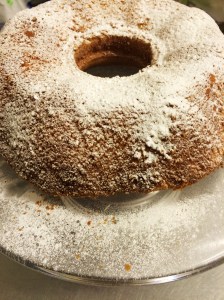No matter how much I watch Nigella Lawson, this recipe will always be my favourite one that I’ve made; her Lemon Yoghurt Pot Cake from Nigellissima is a soft delicate cake which is incredibly moist and light.
Nigella suggests using a savarin mould (or ciambella) but without such a mould, I had to root around my baking box to find some attractive tins for this cake. I had a gugelhupf mould which replicated the savarin with the hole in the centre (which allows the centre of the cake to properly bake) but I also found 12 barquette (boat shaped) moulds.
The great thing about barquettes is not only are they small and perfect to bake petit fours in, or any small cake for an afternoon tea or garden party, because the tins are so thin and small, the heat conducts incredibly well meaning you get those slightly darker edges that are beautifully crisp and add a slight crunch; they remind me of madeleines.
The idea of the recipe is that the ingredients (except the vanilla extract) are measured in a yoghurt pot. And whilst I love the romanticism of using the yoghurt pot to measure it all out, I think really the metric equivalents are the way to go here because baking is just so precise.
Here are some other food bloggers who have blogged Nigella’s recipes:
The Dinner Bell’s Chilli Chocolate Cheesecake
The original recipe can be found here
3 eggs, separated
150g natural full fat yoghurt
220g granulated sugar plus 30g for the egg whites
150ml vegetable oil
1 ½ tsp vanilla extract
Zest of a lemon
150g plain flour
100g cornflour (I used potato starch)
Preheat the oven to 180°C. Grease a 23cm gugelhupf mould and 12 barquettes with vegetable oil well. As Nigella says, 23cm springform tins can be used too.
Mix the egg yolks, yoghurt and sugar until they are light and airy; it will be slightly lighter in colour. Add in the oil gradually, continuously whisking. Mix through the vanilla and lemon zest. Sift in the 2 flours and fold them through, beating to start.
In a separate clean bowl, whisk the egg whites with the 30g of sugar until they are holding stiff peaks. Take a third and beat them into the cake batter until incorporated and then fold through the remaining two-thirds gently until the batter is even.
Pour into the 12 barquettes first before filling the gugelhupf with the rest of the batter.
Bake the barquettes for about 12 – 15 minutes until the edges are brown and the cake springs back when touched. Bake the gugelhupf for about 30 – 35 minutes.
Allow them to cool in the tins for 10 minutes before cooling on a wire rack completely. Dust with icing sugar and serve with tea or coffee.







